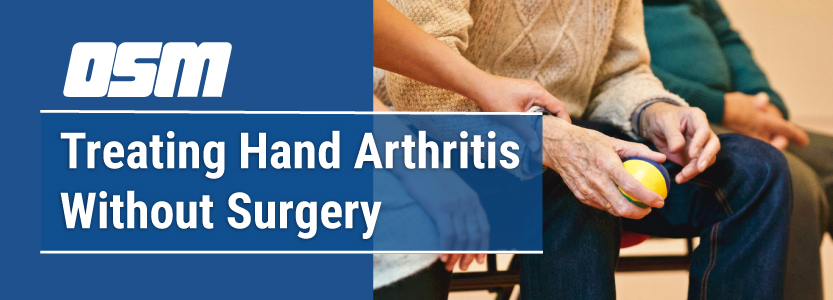Treating Hand Arthritis Without Surgery
Article featured on American Society for Surgery of the Hand
What is arthritis?
A joint is where two or more bones meet each other. The ends of these bones are covered with a smooth substance called cartilage which allows the bones to slide past each other smoothly. This cartilage layer can be worn away with time or due to other things, and when this occurs the rough bone ends start to rub against each other. This is arthritis. Sometimes arthritis does not cause any problems, but sometimes it can cause pain, swelling, stiffness, and deformity.
What causes arthritis?
The most common causes of arthritis are different for different locations in the body. The normal arthritis that often comes along with age is called osteoarthritis. This is simply arthritis that occurs due to normal wear and tear on the body as we get older. Often this type of arthritis is partially hereditary, meaning that if your parents or grandparents had arthritis, you may be more likely to have it. Other things can cause arthritis as well. These include major joint injuries or infections, and certain medical conditions.
Just because you have arthritis doesn’t mean it’s necessarily a problem. Many people have arthritis that they don’t even know about. Arthritis only needs treatment if it bothers you or causes issues in the body.
My hand arthritis hurts! How can I treat it?
Once arthritis is present, it will always be there. This is because the body can’t regrow the type of cartilage found in the joints. But there is good news: just because arthritis is in the body doesn’t mean it will always cause pain or other issues. Even if arthritis causes pain, the pain may not be there all the time- it can often come and go. There are many things we can do to try to improve arthritis symptoms when they occur. Conservative management of arthritis- meaning treatment without surgery- is almost always the first step. There are many options to try. Usually these treatments work best when they are used all together over several weeks or months.
- Splints: resting the inflamed joint with a splint, also called a brace or “orthosis”, can be very helpful in improving arthritis symptoms in certain places in the hand, especially arthritis in the base of the thumb. Splints may be “pre-fabricated”, meaning that you can buy them at the store or online and they are designed to fit most people. Other splints can be custom molded to your hand by a hand therapist.
- Rest: avoiding activities that flare up the arthritis pain can make the pain less intense or less frequent.
- Ice or heat: using ice on the skin over an arthritic joint before and after any activities that worsen the pain can improve discomfort. Heat applied with warm compresses, warm water, or wax baths may also improve symptoms. Experiment with both ice and heat to see if either helps.
- Medications: anti-inflammatory medications like ibuprofen or naproxen may help improve pain. Acetominophen can also be helpful. If you have medical problems or take medications, check with your primary care provider to make sure it is safe for you to take these medicines.
- Rub-on creams: Some creams and lotions rubbed into the skin over an arthritic joint can be helpful in decreasing pain there. There are multiple options which may be worth trying, most of which can be bought at your local drug store or online. Try one for a few days or weeks, and if it doesn’t help then try another.
- Injections: In some arthritic joints, certain substances can be injected into the joint with a needle which can decrease pain. Depending on the location, receiving a needle injection may be temporarily painful, but can provide good pain relief for months or longer. Many hand doctors provide injections of steroid, a substance that is thought to decrease inflammation in a joint which may be able to improve pain for several months. Some hand doctors may also consider injections of hyaluronate, a substance which may temporarily allow roughened bone ends to slip past each other more comfortably. However, hyaluronate injections are less commonly used than steroid injections and may be more expensive.
- Hand therapy: Working with a hand therapist on motion exercises and strengthening of the hand may help improve some people’s arthritis pain, but the scientific studies on therapy for arthritis do not prove that it helps a great deal.
What if none of these treatments work to improve my arthritis pain?
There are surgeries that can help make hand arthritis pain better. However, most people with hand arthritis never need to move forward with surgery- this is a personal decision that should be made after discussion with a hand surgeon. The safest and best plan is usually to try to maximize all non-surgery treatments to make arthritis feel better. If none of these treatments give you good relief from your arthritis symptoms, see a hand surgeon to discuss whether a surgical procedure could benefit you.
The Orthopedic & Sports Medicine Center of Oregon is an award-winning, board-certified orthopedic group located in downtown Portland Oregon. We utilize both surgical and nonsurgical means to treat musculoskeletal trauma, spine diseases, foot and ankle conditions, sports injuries, degenerative diseases, infections, tumors and congenital disorders.
Our mission is to return our patients back to pain-free mobility and full strength as quickly and painlessly as possible using both surgical and non-surgical orthopedic procedures.
Our expert physicians provide leading-edge, comprehensive care in the diagnosis and treatment of orthopedic conditions, including total joint replacement and sports medicine. We apply the latest state-of-the-art techniques in order to return our patients to their active lifestyle.
If you’re looking for compassionate, expert orthopedic and podiatric surgeons in Portland Oregon, contact OSM today.
Phone:
Address
17355 Lower Boones Ferry Rd Suite 100A
Lake Oswego, OR 97035
Hours
Monday–Friday
8:00am – 4:30pm



